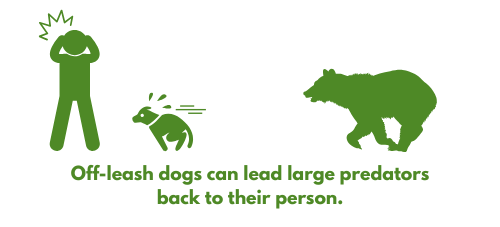Be a PAWSitive Influence!
Dogs are welcome at most EALT conservation lands, under the following conditions:
There are some sites where dogs are not permitted at all. This is because these areas are especially sensitive to disturbance by domestic animals, as the presence of dogs can change the natural behaviours of wildlife that rely on these habitats to breed. These areas are:
Dogs must be on a leash for the duration of your visit
This is mandatory for those visiting with pets. This is because:
A leash ensures you and your pet stay safe. It’s always possible that large predators such as cougars and bears are present on EALT conservation lands, and off-leash dogs may lead a bear or cougar back to their human. Dogs are subject to their instincts, and if they chase something they’re not able to deal with, they will likely return to their human for safety - creating a dangerous situation for you both.
A leash ensures wildlife safety. Small animals, birds, and baby ungulates are at risk whenever they encounter an off-leash dog. EALT has had baby animals killed on our lands as a result of off-leash dogs. No matter what training level you and your dog have achieved, we ask that you respect the sensitive habitats present at all of our conservation lands by keeping them on a leash.
A leash makes it easier to find their poop! When dogs are off-leash, it’s often very hard to find and pick up their poop, because you don’t know where they might have been.
Please arrange to spend off-leash time with your dog in areas designated for it. Many options are available in Edmonton, Wetaskiwin, Stony Plain, Spruce Grove, and other places. There are also private options in some rural areas for those seeking space for dogs with reactive behaviour to enjoy time off-leash, which you can find here.
Dog poop must be picked up and disposed of off-site
Leaving your dog poop behind may seem harmless, but there’s several reasons why it’s harmful. EALT does not maintain garbage bins on our conservation lands, due to our limited capacity. Our conservation lands are owned privately, and we do not have custodial services like municipal garbage removal at our sites.
It does not biodegrade quickly. On average, dog poop takes roughly 9 weeks to decompose. In the meantime, dozens, if not hundreds of visitors have the chance to take it home with them on their shoes - yuck!
It’s a pollutant. Dogs, on average, have nutrient-rich diets fed to them by loving humans, but this makes their poop problematic in natural areas. The artificially high proportion of nutrients, such as nitrates, enter the groundwater and contribute to algal blooms and contaminants in lakes and waterways.
In addition to environmental contamination, dog poop also has a high proportion of diseases that can be transmitted to humans, or even other peoples’ pets. These include salmonella, parasites, and other dangerous diseases.
It’s littering. Dog poop is introduced to natural areas by humans, and just like you wouldn’t leave a plastic food wrapper in the middle of the trail, please don’t abandon your dog’s poop.
Thank you for helping to make our conservation lands safe and clean!
Do you want to conserve nature, respect wildlife, and make a PAWSitive impact?





